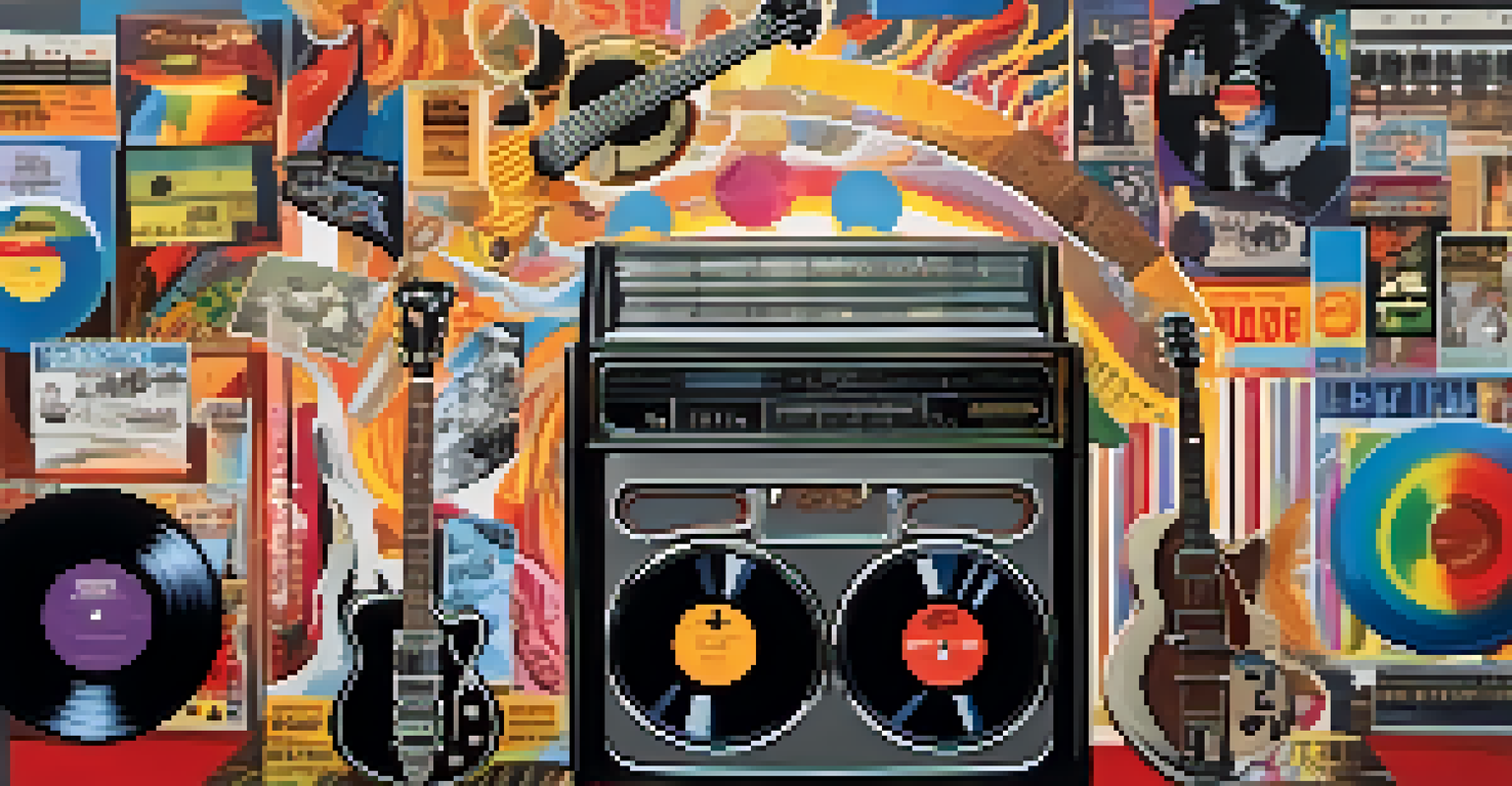Rock and Roll: How American Culture Shaped Guitar Music

The Birth of Rock and Roll in America
Rock and roll emerged in the United States during the late 1940s and early 1950s, symbolizing a cultural revolution. It was a fusion of various musical styles, including jazz, blues, and country, reflecting the diverse American experience. As artists began to experiment with electric guitars, rock and roll quickly became a sound that resonated with the youth, offering a voice for their desires and frustrations.
Rock and roll is a music genre that emerged in the United States in the late 1940s and early 1950s. It was the first music genre that was based on the cultural mixing of different styles and sounds.
This era saw the rise of iconic figures like Chuck Berry and Elvis Presley, who not only defined the genre but also shaped the cultural landscape. Their energetic performances and relatable lyrics spoke to a generation longing for change and self-expression. The music became a catalyst for social movements, influencing everything from fashion to attitudes towards race and gender.
Rock and roll was more than just a genre; it was a cultural phenomenon that broke down barriers. It encouraged young people to challenge societal norms, creating a sense of freedom that was reflected in the music itself. As rock and roll began to take shape, it set the stage for future musical exploration and cultural shifts.
The Influence of African American Music
At the heart of rock and roll's creation was the profound influence of African American music genres, particularly blues and rhythm and blues. These styles brought raw emotion and storytelling to the forefront, captivating audiences across demographic lines. Artists like Muddy Waters and B.B. King laid the groundwork for future rock musicians with their powerful guitar riffs and soulful vocals.

The incorporation of these styles not only enriched the sound of rock and roll but also highlighted issues of race and representation in America. As white artists began to cover songs by Black musicians, it sparked conversations about cultural appropriation and the need for greater recognition of the original creators. This dynamic interplay between races in music was pivotal in shaping the identity of rock and roll.
Rock and Roll's Cultural Impact
Rock and roll emerged as a voice for youth, challenging societal norms and influencing social movements.
Furthermore, the blues' emotional depth provided a template for rock music's lyrical content. Themes of love, heartbreak, and resilience became common, allowing listeners to connect with the music on a personal level. This connection helped solidify rock and roll's place in American culture as a voice for the voiceless.
The Electric Guitar: An Iconic Instrument
The electric guitar emerged as the defining instrument of rock and roll, capturing the spirit of the genre. Its ability to produce powerful, amplified sounds set it apart from traditional acoustic instruments, allowing musicians to experiment with distortion and effects. This innovation enabled guitarists to express themselves more freely, creating an unmistakable sound that became synonymous with rock.
The electric guitar is the instrument that defined rock and roll, allowing musicians to break boundaries and express themselves in ways never thought possible.
Legendary guitarists like Jimi Hendrix and Eric Clapton pushed the boundaries of what the electric guitar could do, captivating audiences with their technical prowess and unique styles. Their performances often transformed into sonic experiences, showcasing the instrument's versatility and emotional range. Each strum and riff told a story, resonating deeply with fans around the world.
Moreover, the electric guitar became a symbol of rebellion and individuality. It represented a break from the past, empowering musicians to create their own identities and challenge societal expectations. As rock and roll grew, so did the electric guitar's status, cementing its place at the forefront of American music culture.
Rock and Roll's Role in Shaping Youth Culture
Rock and roll played a significant role in shaping the identity of youth culture in America during the 1950s and 1960s. The music provided a soundtrack for a generation that was eager to assert its independence and explore new ideas. It encouraged young people to embrace their individuality, often leading to the formation of distinct subcultures based on musical tastes and fashion choices.
Concerts and festivals became gathering places where young people could connect and share their passion for music. Events like Woodstock not only showcased iconic performances but also symbolized a collective desire for peace, love, and social change. This camaraderie among fans fostered a sense of belonging, further solidifying rock and roll's impact on youth culture.
Influence of African American Music
The genre's roots in blues and rhythm and blues showcased the emotional depth and storytelling that defined rock and roll.
As the genre evolved, it continued to reflect the changing values and concerns of young Americans. The emergence of punk, grunge, and alternative rock each brought new perspectives on rebellion and societal issues, showcasing the genre's adaptability. Rock and roll became a vehicle for self-expression, allowing youth to voice their opinions and aspirations.
The Intersection of Politics and Rock Music
Throughout its history, rock and roll has been intertwined with political movements, often serving as a powerful tool for social change. Artists used their platforms to address issues like civil rights, war, and environmentalism, mobilizing fans to take action. Songs like 'Fortunate Son' by Creedence Clearwater Revival became anthems for protests, reflecting the frustrations of a generation disillusioned with the status quo.
The 1960s and 1970s saw an explosion of politically charged music, with artists like Bob Dylan and Joan Baez leading the charge. Their lyrics challenged listeners to think critically about societal norms and injustices, encouraging a spirit of activism. This connection between music and politics not only enriched the rock genre but also empowered fans to engage in meaningful conversations about the world around them.
As the years progressed, the relationship between rock music and politics remained strong. Contemporary artists continue to use their music as a platform to advocate for change, ensuring that the genre remains relevant in addressing today's challenges. This legacy of activism highlights how rock and roll is not just entertainment; it is a reflection of societal values and aspirations.
The Globalization of Rock and Roll
As rock and roll gained popularity in the United States, it began to transcend borders, influencing musicians and cultures worldwide. Countries like the UK, Australia, and even Japan embraced the genre, creating their unique interpretations that often blended local styles with classic rock elements. This globalization allowed rock music to evolve, resulting in a rich tapestry of sounds and styles that reflect diverse cultural experiences.
British rock bands like The Beatles and The Rolling Stones played a significant role in this phenomenon, bringing rock and roll back to America with their distinct flair. Their massive success not only showcased the genre's versatility but also sparked a transatlantic conversation about music and culture. This exchange between countries ultimately enriched the rock landscape, leading to fresh innovations and collaborations.
Globalization of Rock Music
Rock and roll's reach expanded globally, leading to diverse interpretations and collaborations that enriched its sound.
Moreover, the rise of the internet has further accelerated the globalization of rock music. Platforms like YouTube and Spotify enable artists from different corners of the globe to share their work and connect with fans. As a result, rock and roll continues to evolve, drawing inspiration from various cultures while maintaining its core essence as a form of self-expression and rebellion.
The Legacy of Rock and Roll Today
Today, rock and roll remains a vibrant part of American culture, influencing countless genres and artists. Its legacy is evident in the music of contemporary artists who draw inspiration from rock's rebellious spirit and emotional depth. With the rise of indie rock, pop-punk, and alternative genres, the essence of rock and roll continues to thrive, appealing to new generations of listeners.
Moreover, the continued evolution of technology has transformed how rock music is created and consumed. Artists now have access to advanced tools that allow for innovative sounds and production techniques, pushing the boundaries of the genre. This blend of tradition and innovation ensures that rock and roll remains relevant in an ever-changing musical landscape.

Furthermore, rock and roll's cultural significance is celebrated through various festivals, documentaries, and tributes that honor its history and impact. As new artists emerge and old classics endure, the genre remains a testament to the power of music in shaping society and expressing the human experience. The legacy of rock and roll is not just about the sound; it’s about connection, identity, and the ongoing pursuit of freedom.